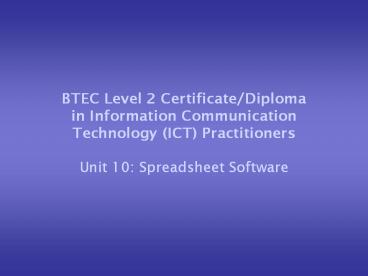BTEC Level 2 Certificate/Diploma in Information Communication Technology (ICT) Practitioners - PowerPoint PPT Presentation
1 / 15
Title:
BTEC Level 2 Certificate/Diploma in Information Communication Technology (ICT) Practitioners
Description:
BTEC Level 2 Certificate/Diploma. in Information Communication ... Manipulation of lists as flat file databases. Terminology (e.g. cells, rows, fields, columns) ... – PowerPoint PPT presentation
Number of Views:219
Avg rating:3.0/5.0
Title: BTEC Level 2 Certificate/Diploma in Information Communication Technology (ICT) Practitioners
1
BTEC Level 2 Certificate/Diplomain Information
Communication Technology (ICT) Practitioners
- Unit 10 Spreadsheet Software
2
Nature and purpose
- Manipulation of structured mainly numeric data.
- Presentation of information.
- Manipulation of lists as flat file databases.
- Terminology (e.g. cells, rows, fields, columns).
- Workbooks.
- Examples of uses in industry and commerce.
3
Uses of spreadsheets
- Presentation of information (e.g. to clarify
relationships or interpret data). - Repetitively and accurately performing
calculations (e.g. payroll, statistics). - List management (e.g. searching large datasets,
interpreting data using sorting and filtering.
4
User need
- Processing requirements.
- Input and output.
5
Formulae
- Simple mathematical formulae (add, subtract,
divide, multiply) (e.g. calculating VAT,
totalling columns of figures). - Complex formulae involving two stage calculations
(e.g. calculations of pay based on basic hours
and overtime, compound interest).
6
Functions
- Statistical functions (e.g. average, min, max,
count, countif). - Logical functions (e.g. IF, OR, AND).
7
Entering and editing data
- Absolute and relative cell referencing.
- Autofilling cells.
- Linking cells between different spreadsheets or
workbooks. - Use of paste and paste link.
8
Improving efficiency
- Shortcuts (e.g. to aid movement around multisheet
spreadsheet, to perform complex formatting).
9
Combining information
- Between different application packages (e.g.
inserting graphs produced into word processed
documents).
10
File handling
- File management (e.g. naming files, folder
structures, moving and deleting files).
11
Presenting data
- Appropriate data types (text, currency and date).
- Formatting cells (colours, shading, alignment,
borders). - Other formatting (e.g. increasing/decreasing
decimal points, merging cells). - Formatting charts (e.g. titles and labels,
resizing and moving).
12
Presenting data
- Choice of chart type.
- Formatting sheets (e.g. headers and footers,
adjust page set-up for printing, appropriate page
breaks).
13
Analysing and interpreting data
- Converting spreadsheet data to charts and graphs.
- Filtering and sorting lists.
- Choice of methods for complex spreadsheets.
14
Checking
- Check formulae and functions work correctly.
- Sorting out errors.
- User requirements met.
15
Documentation
- User requirements.
- Detail of formulae and functions used.































